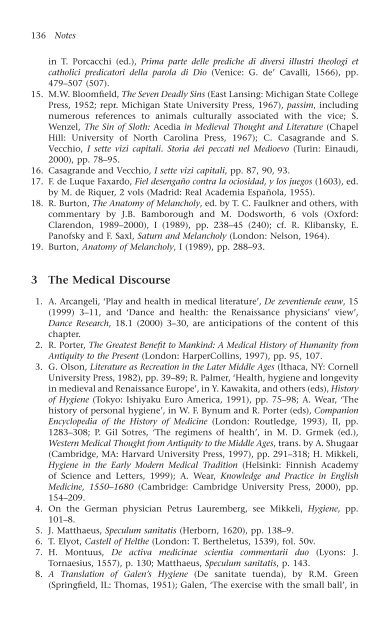Recreation in the Renaissance
Recreation in the Renaissance
Recreation in the Renaissance
- No tags were found...
Create successful ePaper yourself
Turn your PDF publications into a flip-book with our unique Google optimized e-Paper software.
136 Notes<br />
<strong>in</strong> T. Porcacchi (ed.), Prima parte delle prediche di diversi illustri <strong>the</strong>ologi et<br />
catholici predicatori della parola di Dio (Venice: G. de’ Cavalli, 1566), pp.<br />
479–507 (507).<br />
15. M.W. Bloomfield, The Seven Deadly S<strong>in</strong>s (East Lans<strong>in</strong>g: Michigan State College<br />
Press, 1952; repr. Michigan State University Press, 1967), passim, <strong>in</strong>clud<strong>in</strong>g<br />
numerous references to animals culturally associated with <strong>the</strong> vice; S.<br />
Wenzel, The S<strong>in</strong> of Sloth: Acedia <strong>in</strong> Medieval Thought and Literature (Chapel<br />
Hill: University of North Carol<strong>in</strong>a Press, 1967); C. Casagrande and S.<br />
Vecchio, I sette vizi capitali. Storia dei peccati nel Medioevo (Tur<strong>in</strong>: E<strong>in</strong>audi,<br />
2000), pp. 78–95.<br />
16. Casagrande and Vecchio, I sette vizi capitali, pp. 87, 90, 93.<br />
17. F. de Luque Faxardo, Fiel desengaño contra la ociosidad, y los juegos (1603), ed.<br />
by M. de Riquer, 2 vols (Madrid: Real Academia Española, 1955).<br />
18. R. Burton, The Anatomy of Melancholy, ed. by T. C. Faulkner and o<strong>the</strong>rs, with<br />
commentary by J.B. Bamborough and M. Dodsworth, 6 vols (Oxford:<br />
Clarendon, 1989–2000), I (1989), pp. 238–45 (240); cf. R. Klibansky, E.<br />
Panofsky and F. Saxl, Saturn and Melancholy (London: Nelson, 1964).<br />
19. Burton, Anatomy of Melancholy, I (1989), pp. 288–93.<br />
3 The Medical Discourse<br />
1. A. Arcangeli, ‘Play and health <strong>in</strong> medical literature’, De zeventiende eeuw, 15<br />
(1999) 3–11, and ‘Dance and health: <strong>the</strong> <strong>Renaissance</strong> physicians’ view’,<br />
Dance Research, 18.1 (2000) 3–30, are anticipations of <strong>the</strong> content of this<br />
chapter.<br />
2. R. Porter, The Greatest Benefit to Mank<strong>in</strong>d: A Medical History of Humanity from<br />
Antiquity to <strong>the</strong> Present (London: HarperColl<strong>in</strong>s, 1997), pp. 95, 107.<br />
3. G. Olson, Literature as <strong>Recreation</strong> <strong>in</strong> <strong>the</strong> Later Middle Ages (Ithaca, NY: Cornell<br />
University Press, 1982), pp. 39–89; R. Palmer, ‘Health, hygiene and longevity<br />
<strong>in</strong> medieval and <strong>Renaissance</strong> Europe’, <strong>in</strong> Y. Kawakita, and o<strong>the</strong>rs (eds), History<br />
of Hygiene (Tokyo: Ishiyaku Euro America, 1991), pp. 75–98; A. Wear, ‘The<br />
history of personal hygiene’, <strong>in</strong> W. F. Bynum and R. Porter (eds), Companion<br />
Encyclopedia of <strong>the</strong> History of Medic<strong>in</strong>e (London: Routledge, 1993), II, pp.<br />
1283–308; P. Gil Sotres, ‘The regimens of health’, <strong>in</strong> M. D. Grmek (ed.),<br />
Western Medical Thought from Antiquity to <strong>the</strong> Middle Ages, trans. by A. Shugaar<br />
(Cambridge, MA: Harvard University Press, 1997), pp. 291–318; H. Mikkeli,<br />
Hygiene <strong>in</strong> <strong>the</strong> Early Modern Medical Tradition (Hels<strong>in</strong>ki: F<strong>in</strong>nish Academy<br />
of Science and Letters, 1999); A. Wear, Knowledge and Practice <strong>in</strong> English<br />
Medic<strong>in</strong>e, 1550–1680 (Cambridge: Cambridge University Press, 2000), pp.<br />
154–209.<br />
4. On <strong>the</strong> German physician Petrus Lauremberg, see Mikkeli, Hygiene, pp.<br />
101–8.<br />
5. J. Matthaeus, Speculum sanitatis (Herborn, 1620), pp. 138–9.<br />
6. T. Elyot, Castell of Hel<strong>the</strong> (London: T. Ber<strong>the</strong>letus, 1539), fol. 50v.<br />
7. H. Montuus, De activa medic<strong>in</strong>ae scientia commentarii duo (Lyons: J.<br />
Tornaesius, 1557), p. 130; Matthaeus, Speculum sanitatis, p. 143.<br />
8. A Translation of Galen’s Hygiene (De sanitate tuenda), by R.M. Green<br />
(Spr<strong>in</strong>gfield, IL: Thomas, 1951); Galen, ‘The exercise with <strong>the</strong> small ball’, <strong>in</strong>










